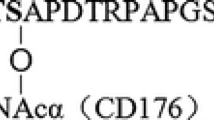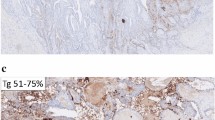Abstract
We have previously analyzed the expression of MUC1, underglycosylated MUC1, MUC2, MUC5AC, Tn, sialyl Tn, Lewisa, sialyl Lewisa, Lewisx, and sialyl Lewisx in papillary thyroid carcinoma (PTC). The present study of 26 thoroughly scrutinized cases of PTC with “good” or “bad outcome” and a minimum of 10 yr of follow-up (or until death of the patients) was undertaken in an attempt to find if there is any relationship between the expression of the aforementioned antigens and the clinicopathologic and morphologic features of the cases and to evaluate the prognostic significance of the immunohistochemical pattern of PTC. We observed a significant or suggestive association between the expression of MUC1, underglycosylated MUC1, MUC2, Lewisa, and Lewisx and the older age of the patients, and a suggestive association between Lewisx expression and lymph node metastasis and venous invasion. There was also a strong correlation between extrathyroid invasion, lymph node metastasis, intrathyroid dissemination, and venous invasion and patients outcome thus demonstrating, once more, the prominence of the classic clinicopathologic and morphologic features in the prognostic evaluation of PTC. The immunohistochemical study of mucins, simple mucin antigens, and histo-blood group antigens did not provide additional prognostic information, but for the significant association of Lewisx immunoreactivity to the group of “bad outcome.”
Similar content being viewed by others
References
Longenecker BM Introduction: Glycosylation changes associated to malignancy. Sem Cancer Biol 2:355–356, 1991.
Hakomory S. Aberrant glycosylation in tumors and tumor-associated carbohydrate antigens. Adv Cancer Res 52:257–331, 1992.
Ho SB, Niehans GA, Lyftogt C, Yan PS, Cherwitz DL, Gum ET, Dahiya R, Kim YS. Heterogeneity of mucin gene expression in normal and neoplastic tissues. Cancer Res 53:641–651, 1993.
Schmitt FC, Figueiredo P, Lacerda M. Simple mucin-type carbohydrate antigens (T, sialosyl-T, Tn and sialosyl-Tn) in breast carcinogenesis. Virchows Arch 427:251–258, 1995.
Soares R, Marinho A, Schmitt F. Expression of sialyl-Tn in breast cancer. Correlation with porgnostic parameters. Pathol Res Pract 192:1181–1186, 1996.
Narita T, Funahashi H, Satoh Y, Watanabe T, Sakamoto J, Takagi H. Association of expression of blood group-related carbohydrate antigens with prognosis in breat cancer. Cancer 71:3044–3053, 1993.
Cho SH, Sahin A, Hortobagyi GN, Hittelman WN, Dhingra K. Sialyl-Tn antigen expression occurs early during human mammary carcinogenesis and is associated with high nuclear grade and aneuploidy. Cancer Res 54:6302–6305, 1994.
Mayer B, Funke I, Johnson JP. High expression of a Lewis (x)-related epitope in gastric carcinomas indicates metastatic potential and poor prognosis. Gastroenterology 111:1433–1446, 1996.
Victorzon M, Nordling S, Nilson O, Roberts PJ, Haglund C. Sialyl Tn antigen is an independent predictor of outcome in patients with gastric cancer. Int J Cancer 65:295–300, 1996.
Werther JL, Tatematsu M, Klein R, Kurihara M, Kumagai K, Llorens P, Guidugli Neto J, Bodian C, Pertsemlidis D, Yamachika T, Kitou T, Itzkowitz S. Sialosyl-Tn antigen as a marker of gastric cancer progression: an international study. Int J Cancer 69:193–199, 1996.
Carneiro F, Amado M, David L, Clausen H, Sobrinho-Simões M. Glycosylation features of gastric carcinoma initiation and progression. A review with emphasis on simple mucin-type carbohydrates and histo-blood group antigens of the Lewis system. Euro J Cancer Prev. 3 (supl 2):29–46, 1994.
Singhal AK, Orntoft TF, Nudelman E, Nance S, Schibig L, Stroud MR, Clausen H, Hakomori S. Profiles of Lewisx-containing glycoproteins and glycolipids in sera of patients with adenocarcinoma. Cancer Res 50:1375–1380, 1990.
Ghazizadeh M, Ogawa H, Sasaki Y, Araki T, Arihara k. Mucin carbohydrate antigens (T, Tn and sialyl-Tn) in human ovarian carcinomas: relationship with histopathology and prognosis. Hum Pathol 28:960–966, 1997.
Jorsensen T, Berner A, Kaalhus O, Tveter KJ, Danielsen HE, Bryne M. Up-regulation of the oligosaccharide sialyl LewisX: a new prognostic parameter in metastatic prostate cancer. Cancer Res 55:1817–1819, 1995.
Fonseca E, Soares P, Rossi S, Sobrinho-Simoes M. Prognostic factors in thyroid carcinomas. Verh Dtsch Ges Pathol 81:82–96, 1997.
Gendler SJ, Spicer AP, Lalani EN, Duhig T, Peat N, Burchell J, Pemberto L, Boshell M and Taylor-Papadimitrou. Structure and biology of a carcinoma-associated mucin, MUC1. Am Rev Respir Dis 144:S42-S47, 1991.
Damiani S, Fratamico F, Lapertosa G, Dina R and Eusebi V. Alcian Blue and epithelial membrane antigen are useful markers in differentiating benign from malignat papillae in thyroid lesions. Virchows Archiv A Pathol Anat 419:131–135, 1991.
Yamamoto Y, Izumi K, Otsuka H. An immunohistochemical study of epithelial membrane antigen, cytokeratin, and vimentin in papillary thyroid carcinoma. Recognition of lethal and favorable prognostic types. Cancer 70:2326–2333, 1992.
Ostrowski ML, Merino MJ. Tall cell variant of papillary thyroid carcinoma: a reassessment and immunohistochemical study with comparison to the usual type of papillary carcinoma of the thyroid. Am J Surg Pathol, 20:964–74, 1996.
Bryne M, Dabelsten E and Nesland JM. The glycosylation pattern in follicular and papillary thyroid carcinomas. Glycosylation and disease 1:119–125, 1995.
Fonseca E, Castanhas S, Sobrinho-Simões M. Expression of simple mucin type antigens and Lewis type 1 and type 2 chain antigens in the thyroid gland: an Immunohistochemical study of normal thyroid tissues, benign lesions, and malignant tumors. Endocrine Pathol 7:291–301, 1996.
Fonseca E, Sobrinho-Simões M. Expression of Lewis antigens in papillary carcinoma of the thyroid gland. Virchows Arch 432:483, 1998.
Hedinger C, Williams E, Sobin L. Histological typing of thyroid tumors. 2nd ed. WHO International histological classification of tumors. Springer-Verlag, Berlin, 1988.
LiVolsi V. Surgical pathology of the thyroid. WB Saunders, Philadelphia, 1990.
Rosai J. Thyroid gland. In: Ackerman’s Surgical Pathology. 8th ed. Mosby, 1995:493–567.
Sanders LE, Cady B. Differentiated thyroid cancer: reexamination of risk groups and outcome of treatment. Arch Surg 133:419–425, 1998.
Cady B, Rossi R. An expanded view of risk-group definition in differentiated thyroid carcinoma. Surgery 104:947–953, 1988.
Langle F, Soliman T, Neuhold N, Widhalm G, Niederle B, Roka S, Kaserer K, Blauensteiner W, Dam K, Clodi M, et al. CD15 (LeuM1) immunoreactivity: prognostic factor for sporadic and hereditary medullary thyroid cancer? Study Group on Multiple Endocrine Neoplasia of Austria. World J Surg 18:583–587, 1994.
Neuhold N, Langle F, Gnant M, Hollenstein U, Niederle B. Relationship of CD15 immunoreactivity and prognosis in sporadic medullary thyroid carcinoma. J Cancer Res Clin Oncol 118:629–634, 1992.
Schröder S, Schwarz W, Rehpenning W, Loning T, Bocker W. Prognostic significance of Leu-M1 immunostaining in papillary carcinomas of the thyroid gland. Virchows Arch A Pathol Anat Histopathol 411:435–439, 1987.
Satoh H, Ishikawa H, Kamma H, Yamashita YT, Takahashi H, Ohtsuka M, Hasegawa S. Serum sialyl lewis X-i antigen levels in non-small cell lung cancer: correlation with distant metastasis and survival. Clin Cancer Res 3:495–499, 1997.
Amado M, Carneiro F, Seixas M, Clausen H, Sobrinho-Simoes M. Dimeric sialyl-Le(x) expression in gastric carcinoma correlates with venous invasion and poor outcome. Gastroenterology 114:462–470, 1998.
Erhard H, Rietveld FB, Brocker EB, de Waal RM, Ruiter DJ. Phenotype of normal cutaneous microvasculature. Immunoelectron microscopic observations with emphasis on the differences between blood vessels and lymphatics. J Invest Dermatol 106:135–140, 1996.
Author information
Authors and Affiliations
Corresponding author
Rights and permissions
About this article
Cite this article
Alves, P., Soares, P., Rossi, S. et al. Clinicopathologic and prognostic significance of the expression of mucins, simple mucin antigens and histoblood group antigens in papillary thyroid carcinoma. Endocr Pathol 10, 305–313 (1999). https://doi.org/10.1007/BF02739773
Issue Date:
DOI: https://doi.org/10.1007/BF02739773




